

Defining Makerspaces: Part 1. Recently, I had the unfortunate experience of dealing with criticism.
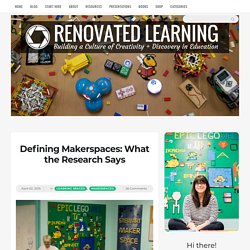
I was told (not to my face) by a visitor to our school that our library makerspace is not a “real makerspace”. This same person stated that our woodshop is a “real makerspace” because it has power tools. She suggested that I “do some research” on what makerspaces actually are. Feeling personally insulted aside, what bothers me most about this statement is the concept that some makerspaces are more valid than others and that a makerspace is solely defined by the tools it contains. I do agree that our woodshop is a makerspace, even though we don’t call it that. But is my space any less of a makerspace simply because it doesn’t have power tools? Setting Up Your Own MakerSpace. Since you already know that you want to set up a MakerSpace you know that it is an area that provides hands-on, creative ways for students to design, experiment, and invent as they engage in science, engineering, and tinkering.”
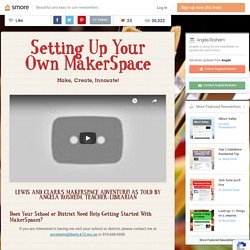
(definition from edutopia) The Makings of a Makerspace: Three Examples. In late October, 2013, I visited several makerspaces in the bay area crammed into one day, and blogged about my discoveries here.
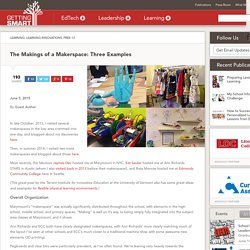
Then, in summer 2014, I visited two more makerspaces and blogged about those here. Most recently, the fabulous Jaymes Dec hosted me at Marymount in NYC, Kat Sauter hosted me at Ann Richards STARS in Austin (whom I also visited back in 2013 before their makerspace!) , and Ross Monroe hosted me at Edmonds Community College here in Seattle. (This great post by the Tarrant Institute for Innovative Education at the University of Vermont also has some great ideas and examples for flexible physical learning environments.)
Overall Organization Marymount’s “makerspace” was actually significantly distributed throughout the school, with elements in the high school, middle school, and primary spaces. Pegboards and clear bins were particularly prevalent, as I’ve often found. Marymount’s bin and pegboard Ann Richards’ pegboards ECC’s pegboard specifically for cardboard cutters. 6 Essential Tips for Designing Your Makerspace’s Layout. When planning a makerspace, most think about designing for creativity.

It’s important to think about the types of projects that will be completed in the space, how many people will use the space at any given time, and the equipment on your must-have versus nice-to-have lists. However, there are also a few considerations that often go overlooked. Nansemond-Suffolk Academy, a fully-accredited private school serving students in pre-kindergarten through twelfth grade with two locations in Suffolk, Virginia Space Utilization – Design, Fabrication, or Both?
It’s important to consider where lab users will be designing versus making. A separate design space should be close to the makerspace in order to minimize lengthy trips back and forth. Resources for Creating a Makerspace. Are you ready to create your own Makerspace?
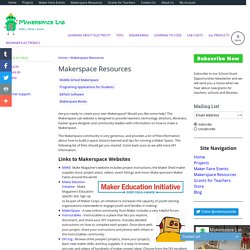
Would you like some help? Why Makerspaces Take Learning to the Next Level. Learn All About STEAM Education and Maker Spaces from @GeekyTeach on this amazing podcast! · TeacherCast Educational Broadcasting NetworkbyJeffrey Bradbury. Podcast: Download | Embed Is your school looking to develop a STEAM lab or a Maker Space?
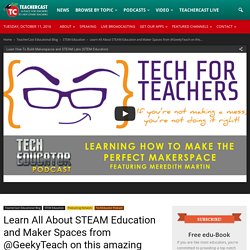
In this episode, Meredith Martin shows us how you can turn a simple room into the innovation lab of your dreams for pennies on the dollar! The TechEducator Podcast is a weekly round table discussion about current topics in educational technology. For more information, please visit www.techeducatorpodcast.com. TechEducatorPodcast.com Hosts: Show Links Thank You For Your Podcast Reviews Are you enjoying Educational Podcasting Today or other shows on the TeacherCast Network, please share your thoughts with the world by commenting on iTunes today. Ask Me Your Podcasting or WordPress Question Are you interested in starting your own podcast?
Contact Me Check Out More TeacherCast Programming View LIVE Professional Development from TeacherCast Need a Presenter? Jeff Bradbury (@TeacherCast) is available as a Keynote Speaker, Presenter, or to Broadcast your conference LIVE! Eli7095. The ideas behind a school makerspace and its benefits for students – Rock Island Techie. When I first heard about makerspaces, I wondered what was so unique about such spaces and what differentiated them from a classroom with materials for projects, the room I use as an office and keep all my art, tech, and office supplies, or even the garage or shed that my husband keeps all his tools and gear for various things.
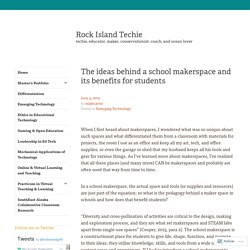
As I’ve learned more about makerspaces, I’ve realized that all these places (and many more) CAN be makerspaces and probably are often used that way from time to time. In a school makerspace, the actual space and tools (or supplies and resources) are just part of the equation; so what is the pedagogy behind a maker space in schools and how does that benefit students? “Diversity and cross-pollination of activities are critical to the design, making and exploration process, and they are what set makerspaces and STEAM labs apart from single-use spaces” (Cooper, 2013, para 2).
What does this mean for the teacher utilizing a makerspace with their students? References: Makerspace Playbook Feb 2013. Creating a space for young makers and educators.